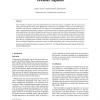Free Online Productivity Tools
i2Speak
i2Symbol
i2OCR
iTex2Img
iWeb2Print
iWeb2Shot
i2Type
iPdf2Split
iPdf2Merge
i2Bopomofo
i2Arabic
i2Style
i2Image
i2PDF
iLatex2Rtf
Sci2ools
CGF
2008
2008
Viewfinder Alignment
The viewfinder of a digital camera has traditionally been used for one purpose: to display to the user a preview of what is seen through the camera's lens. High quality cameras are now available on devices such as mobile phones and PDAs, which provide a platform where the camera is a programmable device, enabling applications such as online computational photography, computer vision-based interactive gaming, and augmented reality. For such online applications, the camera viewfinder provides the user's main interaction with the environment. In this paper, we describe an algorithm for aligning successive viewfinder frames. First, an estimate of inter-frame translation is computed by aligning integral projections of edges in two images. The estimate is then refined to compute a full 2D similarity transformation by aligning point features. Our algorithm is robust to noise, never requires storing more than one viewfinder frame in memory, and runs at 30 frames per second on standa...
Camera | CGF 2008 | Viewfinder | Viewfinder Frame |
| Added | 09 Dec 2010 |
| Updated | 09 Dec 2010 |
| Type | Journal |
| Year | 2008 |
| Where | CGF |
| Authors | Andrew Adams, Natasha Gelfand, Kari Pulli |
Comments (0)

